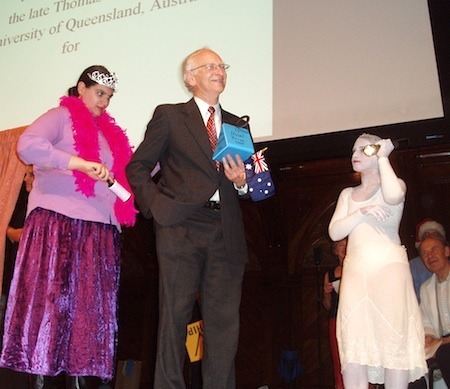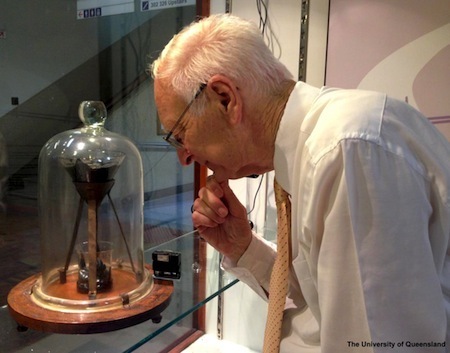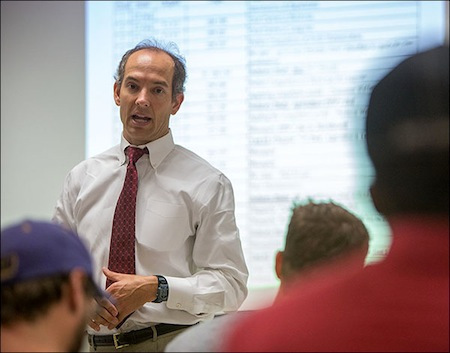Marc Abrahams's Blog, page 468
August 27, 2013
Solar protectivity of beards and moustaches, tested
 Dr Alfio V Parisi [pictured here] and his team stuck beards and moustaches on some dummies, put them out in the hot, hot sun, and measured what happened. They did this after they had run a related experiment with toupees – a trial which itself was preceded by years of painstaking work with tree leaves, automobile windows, adolescent girls, lawn bowlers and snorkelers.
Dr Alfio V Parisi [pictured here] and his team stuck beards and moustaches on some dummies, put them out in the hot, hot sun, and measured what happened. They did this after they had run a related experiment with toupees – a trial which itself was preceded by years of painstaking work with tree leaves, automobile windows, adolescent girls, lawn bowlers and snorkelers.
Parisi and his various collaborators have now published about what’s most dangerous – and what’s maybe a little less so – for people who expose themselves to daylight….
—So begins this month’s Improbable Research column in The Guardian.
Below, detail from one of the studies:

August 26, 2013
1983 Doorknob correction
A correction from the June 1983 issue of Doorknob Collector:
“In the last issue we incorrectly identified the knob at left as coming from the LaSalle Hotel. The knob is actually from the Lexington Hotel, Chicago. Al Capone at one time used two floors of the Lexington as his headquarters. The name was changed to The New Michigan Hotel after Capone’s demise. The knob pictured below is the correct LaSalle knob.”


Sad news: Ig Nobel winner John Mainstone has died
Professor John Mainstone, co-winner of the 2005 Ig Nobel Prize for physics, has died. That prize was awarded to
John Mainstone and the late Thomas Parnell of the University of Queensland, Australia, for patiently conducting an experiment that began in the year 1927 — in which a glob of congealed black tar has been slowly, slowly dripping through a funnel, at a rate of approximately one drop every nine years. [REFERENCE: "The Pitch Drop Experiment," R. Edgeworth, B.J. Dalton and T. Parnell, European Journal of Physics, 1984, pp. 198-200.]
Our deep sympathy goes to his family and many friends. We met Professor Mainstone only once, when he took part in the Ig Nobel Prize ceremony (see photo below). He was a friendly and delightful man.
Here are some of the many news reports about Professor Mainstone’s passing:
ABC News: “Professor John Mainstone, who oversaw Pitch Drop Experiment, dies aged 78“
Libération: “Mort du chercheur chargé de la plus longue expérience scientifique“
Popular Science: “Pitch Drop Experiment Scientist Dies Without Ever Seeing A Drop Fall“
Professor Mainstone took his duties simultaneously seriously and with a deep, happy appreciation of their oddities. Each year, we ask the new Ig Nobel winners to keep their status secret until the moment they are introduced on stage at the ceremony. Professor Mainstone was scrupulous about that. His wife accompanied him in traveling half way around the world from their home in Australia to the ceremony at Harvard University in the US. It was only at the moment the airplane touched ground in Boston that Professor Mainstone told his wife why they were making that long journey.
Here is a photo, supplied by the University of Queensland, of Professor Mainstone watching the pitch drop experiment in what some would call action:
Ps. Just recently, the world — and Professor Mainstone in particular — became aware that a second, similar, pitch drop experiment was being conducted in Dublin, Ireland. That second experiment, begin in 1944 and still progressing, almost certainly was begun in imitation and admiration of the Australian pitch drop experiment.

Spectacular anatomy lesson
A spectacular new understanding or misunderstanding of anatomy is on display in Figure 1 of a new study (click on this link download a PDF of the study). The caption there says:
Fig. 1. CT scan of abdomen and pelvis showing radio-dense bony foreign body perforating through the sigmoid colon (red arrow). Flecks of free intra-peritoneal air can be seen (yellow arrows).
The study itself is:
“Chicken or the leg: Sigmoid colon perforation by ingested poultry fibula proximal to an occult malignancy,” J.D. Terrace, J. Samuel, J.H. Robertson, D.N. Anderson, International Journal of Surgery Case Reports, epub August 12, 2013. The authors are at Western General Hospital in South Edinburgh, UK
(Thanks to investigator Ivan Oransky for alerting us to the study and to the remarkable anatomy lesson contained therein.)

Discovery: Students Who Do Homework Get Higher Grades
A proud press release from East Carolina University announces:
Department of Economics professor Dr. Nick Rupp, who counts education tactics among his research interests, recently published the results of a study in which he found that doing homework assignments leads to higher test grades.
“There’s always been anecdotal evidence,” he explained, “but I wanted to explore it scientifically.”
The study is:
“The Role of Homework in Student Learning Outcomes: Evidence from a Field Experiment,” Andrew Grodner and Nicholas G. Rupp [pictured in the university-supplied glamour photo below], Journal of Economic Education, Volume 44, Issue 2, 2013. (Thanks to investigator Thomas Herron for bringing this to our attention.) The researchers, at East Carolina University, report:
“In this article, the authors describe a field experiment in the classroom where principles of micro- economics students are randomly assigned into homework-required and not-required groups. The authors find that homework plays an important role in student learning, especially so for students who initially perform poorly in the course. Students in the homework-required group have higher retention rates, higher test scores (5 to 6 percent), more good grades (Bs), and lower failure rates.”

Cockroaches of the world, disunite!
AFP reports on the sudden existence of a cockroach diaspora:
One million cockroaches reportedly flee farm in China
At least one million cockroaches have reportedly escaped from a farm in China where they were being bred for use in traditional medicine.
The cockroaches fled the facility in Dafeng, in the eastern province of Jiangsu, for surrounding cornfields after an “unknown perpetrator” destroyed the plastic greenhouse where they were raised, the Modern Express newspaper said.
Disease control authorities have sent five investigators to the area to come up with a plan to stamp out the insects.
Farm owner Wang Pengsheng invested more than 100,000 yuan ($18,100) in 102 kilograms of Periplaneta americana eggs after spending six months developing a business plan, the report said.
By the time the greenhouse was damaged, more than 1.5 million cockroaches had hatched and were being fed food including “fruits and biscuits” every day, Wang was quoted as saying….
(Thanks to investigator Kurt Verkest for bringing this to our attention.)

To appreciate and/or make Martian wine
Is wine as sweet (or as dry, or as whatever) if the grapes are grown in Martian soil? The Martian Terroir project aims or claims to aim to find out. The organizers explain:
Terroir could be defined as the biology of a place. It is a concept that brings the geology, climate, and the life of a territory – including plants, bacteria and wild yeasts – together with human craft, in a sensation that is experienced through agricultural products such as wine.
The process of constructing this terroir consists of a series of simulations of Martian conditions – soil, daylight cycles, daylight composition and clay – that form the base of speculations about the taste and aroma a wine grown and made on Mars might have.
The Mars Acclimatisation Chamber is designed as a mild analogue of Mars in which a grape vine can get accustomed to some of the conditions it would have to face on Mars. This process of acclimatisation will alter the growth and development of the grape vine, influencing the taste of the grapes.…
This video offers further detail:
(Thanks to investigator Vaughn Tan for bringing this to our attention.)

Emotional Gauging of Students via Forehead Wrinkle Extraction
 It’s not always easy to gauge whether students have understood lesson content (or not). Perhaps an automated measuring system could be devised – measuring their forehead wrinkles for example? At least two scholarly texts are available for those interested in the possibilities offered by forehead wrinkle evaluation in the classroom. The first is provided by a UK – based ‘Custom Essay’ firm :‘Identification of student comprehension using forehead wrinkles’ which informs that :
It’s not always easy to gauge whether students have understood lesson content (or not). Perhaps an automated measuring system could be devised – measuring their forehead wrinkles for example? At least two scholarly texts are available for those interested in the possibilities offered by forehead wrinkle evaluation in the classroom. The first is provided by a UK – based ‘Custom Essay’ firm :‘Identification of student comprehension using forehead wrinkles’ which informs that :
“When delivering a lecture, a teacher should use student’s expressions to determine whether or not to slow down, speed up, or in some other way modify his presentation.”
In this respect, the essay describes a technical system which automatically performs :
“Forehead detection, Wrinkle extraction and Emotion recognition.”
The second resource, authored by Professor Dr. M.Mohamed Sathik, M.Sc., M.Phil., M.B.A., M.Tech.,M.S.,Ph.D. and Dr. G.Sofia M.C.A,M.Phil.,(Ph.D), is also entitled : ‘Identification of student comprehension using forehead wrinkles’
It also notes that :
“When delivering a lecture, a teacher should use student’s expressions to determine whether or not to slow down, speed up, or in some other way modify his presentation.”
and the paper also describes a technical system which automatically performs :
“Forehead detection, Wrinkle extraction and Emotion recognition.”
(the paper was published as part of : Computer, Communication and Electrical Technology (ICCCET), 2011 International Conference on )
NOTE : The illustration is taken from another Human Computer Interaction paper which examines the emotional implications of facial expressions, which include wrinkled foreheads. See: ‘Human Computing and Machine Understanding of Human Behaviour’ (International Journal of Emerging Research in Management & Technology, Volume 2, Issue 4, 2013)
More on Professor Dr. M.Mohamed Sathik, M.Sc., M.Phil., M.B.A., M.Tech.,M.S.,Ph.D. and Dr. G.Sofia M.C.A,M.Phil.,(Ph.D) soon …

“Di-Methyl-Doorknob and the Right to Know”
Lingo and euphemism inspire the prose of this short treatise:
“Di-Methyl-Doorknob and the Right to Know,” Harold J. Corbett, EPA Journal, vol. 11, 1985, p. 12.


August 25, 2013
Working to isolate graphene, on national TV
The important activity in this PBS NewsHour interview is happening in the background. David Kessler, co-producer of the Ig Nobel Prize ceremony, doggedly works away with a pencil and Scotch tape to try to isolate graphene. It’s a dramatic re-creation of Andre Geim‘s late-night experiment that led to the awarding of the 2010 Nobel Prize in physics (to Andre Geim and his colleague Konstantin Novosolev). [Ten years before that, in the year 2000, Andre Geim (together with Michael Berry) was awarded an Ig Nobel Prize in physics, for using magnets to levitate a frog.]
The less important activity in this PBS NewsHour interview is in the foreground: news anchor Hari Sreenivasan interviewing me about graphene:
BONUS: Video of the Ig Nobel Prize-winning levitation of a frog:

Marc Abrahams's Blog
- Marc Abrahams's profile
- 14 followers







